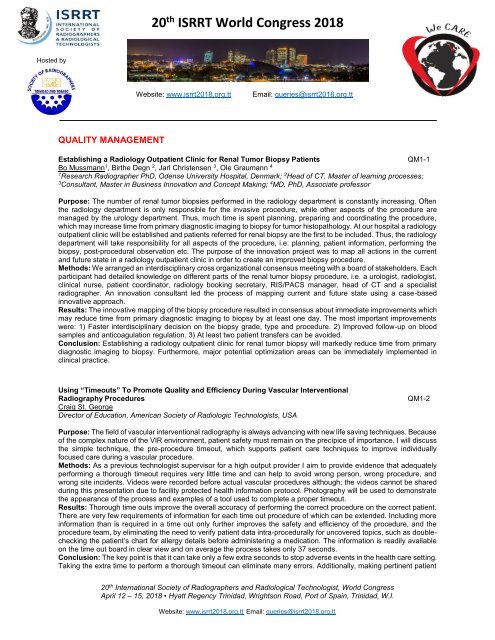Trinidad-and-Tabago-Congerss-Abstract-Book
You also want an ePaper? Increase the reach of your titles
YUMPU automatically turns print PDFs into web optimized ePapers that Google loves.
20 th ISRRT World Congress 2018<br />
Hosted by<br />
Website: www.isrrt2018.org.tt<br />
Email: queries@isrrt2018.org.tt<br />
QUALITY MANAGEMENT<br />
Establishing a Radiology Outpatient Clinic for Renal Tumor Biopsy Patients<br />
QM1-1<br />
Bo Mussmann 1 , Birthe Degn 2 , Jarl Christensen 3 , Ole Graumann 4<br />
1 Research Radiographer PhD, Odense University Hospital, Denmark; 2 Head of CT, Master of learning processes;<br />
3 Consultant, Master in Business Innovation <strong>and</strong> Concept Making; 4 MD, PhD, Associate professor<br />
Purpose: The number of renal tumor biopsies performed in the radiology department is constantly increasing. Often<br />
the radiology department is only responsible for the invasive procedure, while other aspects of the procedure are<br />
managed by the urology department. Thus, much time is spent planning, preparing <strong>and</strong> coordinating the procedure,<br />
which may increase time from primary diagnostic imaging to biopsy for tumor histopathology. At our hospital a radiology<br />
outpatient clinic will be established <strong>and</strong> patients referred for renal biopsy are the first to be included. Thus, the radiology<br />
department will take responsibility for all aspects of the procedure, i.e. planning, patient information, performing the<br />
biopsy, post-procedural observation etc. The purpose of the innovation project was to map all actions in the current<br />
<strong>and</strong> future state in a radiology outpatient clinic in order to create an improved biopsy procedure.<br />
Methods: We arranged an interdisciplinary cross organizational consensus meeting with a board of stakeholders. Each<br />
participant had detailed knowledge on different parts of the renal tumor biopsy procedure, i.e. a urologist, radiologist,<br />
clinical nurse, patient coordinator, radiology booking secretary, RIS/PACS manager, head of CT <strong>and</strong> a specialist<br />
radiographer. An innovation consultant led the process of mapping current <strong>and</strong> future state using a case-based<br />
innovative approach.<br />
Results: The innovative mapping of the biopsy procedure resulted in consensus about immediate improvements which<br />
may reduce time from primary diagnostic imaging to biopsy by at least one day. The most important improvements<br />
were: 1) Faster interdisciplinary decision on the biopsy grade, type <strong>and</strong> procedure. 2) Improved follow-up on blood<br />
samples <strong>and</strong> anticoagulation regulation. 3) At least two patient transfers can be avoided.<br />
Conclusion: Establishing a radiology outpatient clinic for renal tumor biopsy will markedly reduce time from primary<br />
diagnostic imaging to biopsy. Furthermore, major potential optimization areas can be immediately implemented in<br />
clinical practice.<br />
Using “Timeouts” To Promote Quality <strong>and</strong> Efficiency During Vascular Interventional<br />
Radiography Procedures<br />
Craig St. George<br />
Director of Education, American Society of Radiologic Technologists, USA<br />
QM1-2<br />
Purpose: The field of vascular interventional radiography is always advancing with new life saving techniques. Because<br />
of the complex nature of the VIR environment, patient safety must remain on the precipice of importance. I will discuss<br />
the simple technique, the pre-procedure timeout, which supports patient care techniques to improve individually<br />
focused care during a vascular procedure.<br />
Methods: As a previous technologist supervisor for a high output provider I aim to provide evidence that adequately<br />
performing a thorough timeout requires very little time <strong>and</strong> can help to avoid wrong person, wrong procedure, <strong>and</strong><br />
wrong site incidents. Videos were recorded before actual vascular procedures although; the videos cannot be shared<br />
during this presentation due to facility protected health information protocol. Photography will be used to demonstrate<br />
the appearance of the process <strong>and</strong> examples of a tool used to complete a proper timeout.<br />
Results: Thorough time outs improve the overall accuracy of performing the correct procedure on the correct patient.<br />
There are very few requirements of information for each time out procedure of which can be extended. Including more<br />
information than is required in a time out only further improves the safety <strong>and</strong> efficiency of the procedure, <strong>and</strong> the<br />
procedure team, by eliminating the need to verify patient data intra-procedurally for uncovered topics, such as doublechecking<br />
the patient’s chart for allergy details before administering a medication. The information is readily available<br />
on the time out board in clear view <strong>and</strong> on average the process takes only 37 seconds.<br />
Conclusion: The key point is that it can take only a few extra seconds to stop adverse events in the health care setting.<br />
Taking the extra time to perform a thorough timeout can eliminate many errors. Additionally, making pertinent patient<br />
20 th International Society of Radiographers <strong>and</strong> Radiological Technologist, World Congress<br />
April 12 – 15, 2018 • Hyatt Regency <strong>Trinidad</strong>, Wrightson Road, Port of Spain, <strong>Trinidad</strong>, W.I.<br />
Website: www.isrrt2018.org.tt Email: queries@isrrt2018.org.tt


















